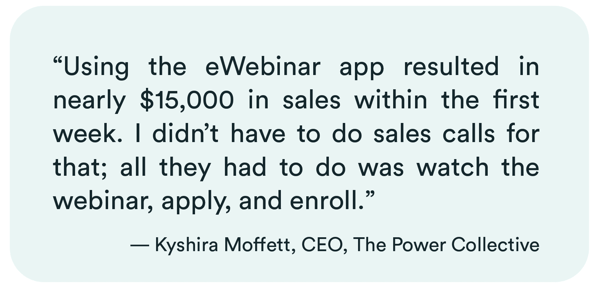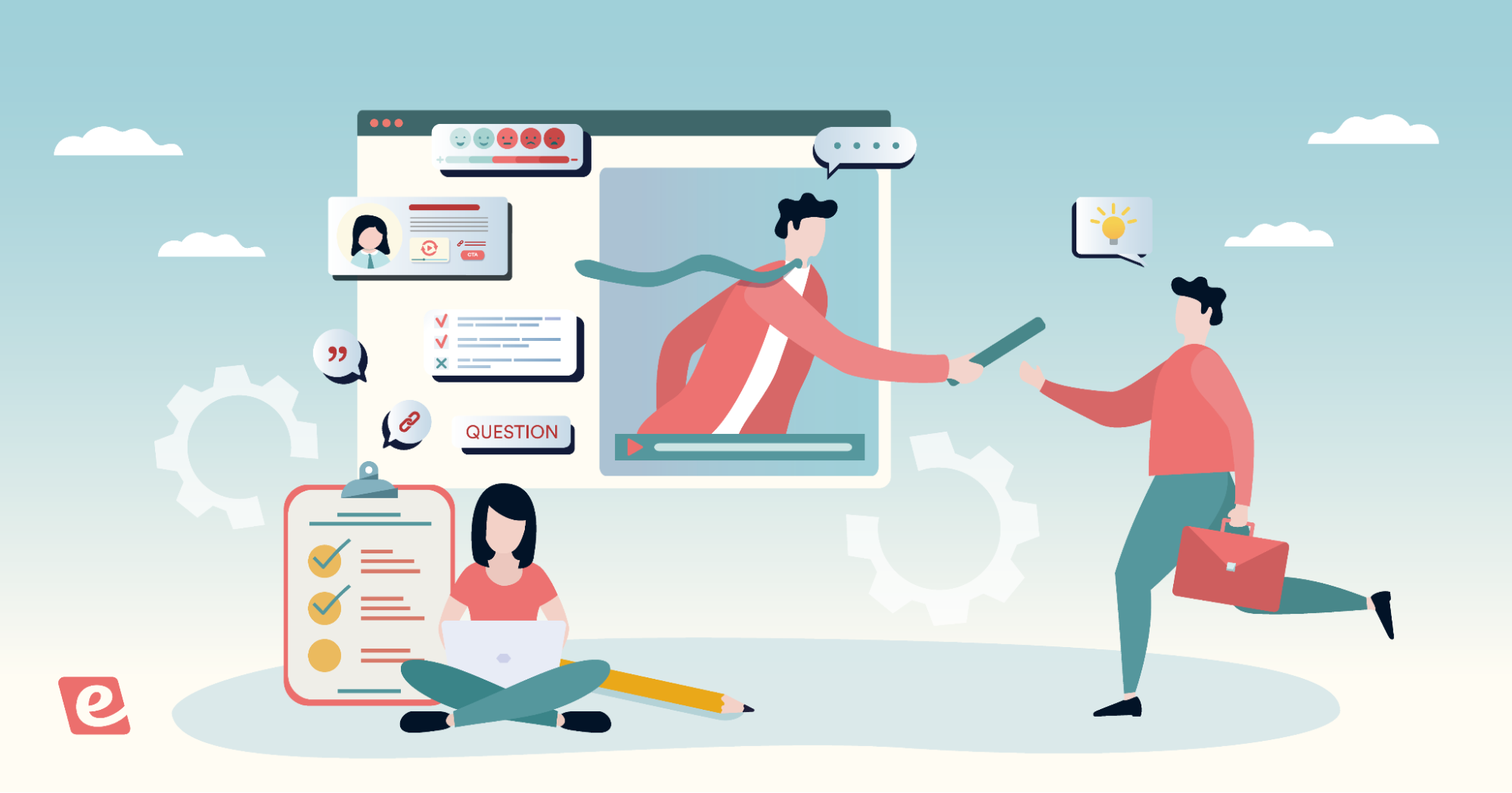How to Launch and Scale a High-Ticket Coaching Program with Automated Webinars
High-ticket coaching programs, which are priced at $5K and above, promise a specific outcome and personal transformation for its participants worthy of a four or five-figure investment. These concierge-like coaching services lay out a highly structured framework that, if followed as outlined, can and will deliver on its promised result. If you are interested in starting a high-ticket coaching program of your own, or scaling the sales of the one you already have, you have come to the right place!
This article was inspired by our webinar How to Scale a High-Ticket Coaching Program with Automated Webinars. In it, Melissa Kwan, CEO and cofounder of eWebinar, asks Kyshira Moffett to share her wealth of expertise and insight into how to create, launch, and scale a high-ticket coaching program with the help of automated webinars.
Kyshira is an International Board Certified Coach and Founder of The Power Collective. She specializes in helping entrepreneurs package their expertise, brand their influence, and monetize their online presence.
If you want the full story, register for the webinar:
If you're looking for an automated webinar tool that, like Kyshira, will help you scale the sales of your coaching program, why not try out the one she uses herself.

To get a brief overview of how eWebinar works, watch this 2-minute explainer video:
For a more comprehensive understanding, you can join our 20-minute on-demand demo.


Otherwise, keep reading and we’ll touch on all of the main points Kyshira and Melissa cover in their conversation:
- 3 main attributes of a high-ticket coaching program
- Three-step process for launching a high-ticket coaching program
- 7 big misconceptions around building and running a high-ticket coaching program
- Developing the skills you need to succeed as a coach
- Understanding impostor syndrome and how to overcome it
- 4 tips for building your audience and attracting new clients
- Why you should use webinars to sell your coaching program
- How to evaluate your sales funnel if your webinars aren’t working
- Why automated webinars are better than live webinars for selling your program
- How to get started with automated webinars
3 main attributes of a high-ticket coaching program
There are three main attributes that set high-ticket coaching programs apart from other coaching programs:
1. Higher price
Price is the defining attribute of a high-ticket coaching program. High-ticket programs offer a personal transformation that people are willing to pay upwards of $5K to experience with the help of a coach. Why? Because the value and benefit that the transformation would bring to their lives is worth the price tag. It’s that simple.
2. Structured to deliver results
When someone is willing to make such a big investment in a coaching program, it means they have a specific problem they are looking to solve and a specific outcome they wish to achieve. The promise of a high-ticket program is that if a person follows a clearly defined roadmap to a T with the right mindset, they will get X result.
While you can get away with a less structured approach in low-ticket programs, like quick intensives and Q&A style working sessions, high-ticket programs must be highly structured and offer a clear framework for achieving a specific promised result. They must have pre-planned curricula, methodologies and techniques that are proven and repeatable.
3. Higher client expectations
When the price of a coaching program is high, client expectations are high too. Clients expect a wealth of resources and materials that comprise the structured framework of the program and make the methods it teaches actionable and repeatable.
They do not want to have to worry about whether or not they are asking the right questions or explaining themselves in the right way to get the desired results; they want a clear path to be laid out for them. They don’t want to have to build their own roadmap. Think of it like a high-end, luxury concierge service.
Three-step process for launching a high-ticket coaching program

Because a high-ticket coaching program must be highly structured and built upon a proven framework, you can’t just throw one together and launch it tomorrow. If you, as a certified coach, do the detailed work up front of defining your program promise and building the accompanying framework, it will not only set you up for success, it will also allow you to price your program accordingly, as a high-ticket offer, from the very beginning.
Here are the three main steps to follow when creating and launching your own high-ticket program.
Step 1: Define a specific program promise
Your ‘program promise’ refers to the transformation people can expect to experience if they enroll and fully participate in your program. Going one step deeper, it is made up of two pieces:
- Your audience, the people who are ideally suited to benefit from your program
- The problem you solve for your audience with your program
When defining your program promise, start with a niche audience. In almost every case, you are going to need to be more specific and go deeper than you think when doing this.
Your goal isn’t to appeal to the general population. Look at luxury brands like Versace, Tesla, and Louis Vuitton. They engage with their audience in a very curated way.
Saying “I help women lose weight” sounds good but isn’t specific enough. “I help single moms regain control of their lives through nutrition” is a much better program promise, has more energy, and will make it much easier to reach your target audience.
Step 2: Build a proven framework that delivers on that promise
Think of a framework like a map. If Point A is where a person is in their lives before they go through your program and Point B is your program promise, your framework is the map to get them from Point A to Point B, with all of the necessary steps in between. You can build out your path by taking all of the steps and turning them into your curriculum, which are the specifics that make up your framework. These include things like:
- What the homework will be for each step
- What actions people will need to take and in what order
- Assessment of clients’ understanding and progress
- What kind of support clients will need (i.e. online communities, client portal, etc.)
- How many coaching calls you will have with them, etc.
Your framework cannot be high level. If you don’t spend enough time up front defining your framework, you will struggle with every client and have a very hard time ensuring a consistent experience.
Step 3: Price your program based on the value of the transformation
Once your program promise and framework are well defined, it is time to put a price tag on everything. There is no quick formula for this, but you should start by doing your due diligence.
Look at other programs that make similar promises and see how they are priced. While level-setting like this is important, don't get caught up in what other people say they offer and try to match them. As long as your framework is sufficient to bring about its intended result, that’s all that matters. You don’t need to start adding things, like bonuses and extra support, to justify the cost. This is called ‘program padding’ and it’s an easy trap to fall into.
This goes for the length of your program too. Don’t make it longer just to justify the price. Your program only needs to be long enough for the desired transformation to occur.
In short, base the price of your program on the value of the transformation it creates, not on its individual pieces, the number of bonuses you offer, or its length.
7 big misconceptions around building and running a high-ticket coaching program

There are a lot of misconceptions out there about how to launch and run a high-ticket coaching program. Here are seven big ones and why they are not true.
1. You have to earn credibility with a low-ticket program
Many people say you need to establish your credibility by starting off with a low-ticket program before you can build something that’s high-ticket. This is not only not true, it can make it very difficult for you to launch a high-ticket program in the future.
Imagine if Walmart started trying to be Prada. Prada customers are not going to suddenly start shopping at Walmart no matter what they say, nor are people going to believe the quality is as good. In the coaching space, why is someone suddenly going to want to give you $5K for your services when all you’ve been offering until then are $10 e-books? It can take years to overcome this kind of perception and build a whole new brand.
2. Your program has to follow a certain structure or standard
t’s easy to think when you look at other coaching programs that yours needs to look a certain way or follow a certain structure or standard. Instead of modeling your program after what everyone else is doing, model yours after your own expertise and on what's actually required to help the client get the promised result. That's what truly matters. There are $10K programs out there that are only six weeks long, because it only takes six weeks to complete the program’s proven roadmap.
3. You shouldn’t be the face of your business
Many people say you shouldn’t be the face of your business because it will make it difficult if you decide to try and scale the business later. While this might be true in some cases, consumers today value having a relationship with a brand.
As coaches, you are your brand. People are buying your method and your framework. Putting your own story out there and becoming a thought leader in your area of expertise lets you cultivate a higher level of respect for your company than you might be able to do otherwise. More than ever today, people are looking for companies that are relatable, authentic, and human.
4. You have to buy your audience with ads
People think you need to dump all your money into paid Facebook ads, for example, when you’re just starting out, as a way to build your audience. This is a really bad idea and can easily land you in debt if you’re not ready. A better way to spend your money in the beginning is on the tools you need to build and nurture your current audience. The process of growing your online course audience organically will allow you to figure out who your audience actually is.
The definition of your target audience will inevitably become narrower over time. If you don’t have that kind of clarity when buying ads, you won’t be able to target your audience in a way that actually reaches them. And that can mean throwing away a lot of money.
5. You shouldn’t give out freebies
The idea that you shouldn’t give anything away for free if you want to play in the high-ticket space is another big misconception. Think of freebies as your first impression. They give someone a chance to get to know you and experience your method firsthand so they can decide if they want to upgrade and enroll in your full program. People aren’t going to be willing to give you $5K or $10K if they don’t actually know what they’ll be getting.
Freebies also allow you to build your email list and database. If you give something to people of value in exchange for their contact information, you then have the ability to continue to impress them through follow up email and text campaigns. If they’re not ready at first, you can get them to the point where they are ready to take the next step and purchase your services.
6. You should take anyone who can pay
When you’re just starting out, it will be tempting to take on any new client who can pay. There are two reasons to be very careful about who you decide to let into your program. First, if your program has a community element to it, one client from hell can destroy the experience for others. If you see the warning signs, politely explain you don’t think your program is a good fit. As scary as it can be to turn away a paying customer, it is better to trust your gut in almost every case.
The other important reason to be mindful of who you let enroll in your program is you need to be sure people have the prerequisites in place to actually succeed. Even though the promise of a high-ticket program is that you get a particular outcome from following a particular roadmap, it doesn’t mean certain things don’t have to be in place first for that to happen. Maybe people already need to be at a certain level in their career or have had a certain amount of experience. Whatever the case may be, don’t set yourself and your client up for failure if you know they’re not ready for your program. If you do, word could start getting around that your program doesn ‘t work. One disgruntled client can do a lot of unnecessary damage on social media!
Treat your program like a VIP experience. Only allow those in who are a good fit for you and your other clients. You’ll save yourself a ton of grief and create the best possible experience for everyone.
7. You have to be available 24/7 to be a top coach
Don’t fall into the trap of thinking you need to make yourself available 24/7 in order to have high-ticket clients. Not having boundaries is a quick recipe for burn out. If you allow your clients to text you at 2am, you will attract clients who text at 2am. Setting clear boundaries will earn you your clients’ respect, scare away the ones who don’t know how to respect boundaries, and make it possible for you to have a life outside of your coaching practice. A tool like an asynchronous coaching platform can help you keep those boundaries and still have personalized, face-to-face conversations with clients.
If you are interested in scaling the sales of your high-ticket coaching program with automated webinars, learn more about the software Kyshira uses in her own business and join eWebinar's 20-minute on-demand demo now!
Developing the skills you need to succeed as a coach
If you are wondering what skills you need to develop in order to succeed in your journey as a business or life coach, they fall into two categories that require two very different mindsets.There are hard skills and soft skills to master when starting a new business.
Learn the hard skills
The hard skills you can learn. If you don’t know how to structure a webinar so that it converts, you can learn to do that. If you don’t know how to structure messaging on a landing page, you can learn how to do that. You can also learn how to use the technology and tools you need to succeed. While these things might not necessarily come easy, hard skills are things you can pick up and learn over time, and there are plenty of resources and people out there who can help.
Focus on the soft skills
Because the hard skills are more tangible, people tend to focus on them more than they do on the soft skills. But the soft skills are the hardest to pick up and require a sustained effort over time to develop. Soft skills include things like empathy, patience, trusting the journey, listening, communication, and self-awareness (which by itself can solve so many problems on its own). Whatever practices you choose to put in place to learn them, make sure you spend more time and effort in the long run on the soft skills than you do on the hard ones, especially if one of your goals is to be satisfied and happy with what you do for a living.
Understanding impostor syndrome and how to overcome it

Impostor syndrome is the false belief that one isn't qualified or good enough to do what he or she does. It happens when we tell ourselves we are going to fail or that there is something wrong with us despite external evidence to the contrary. This evidence can include promotions at work, the number of clients we have, satisfied customers, strong engagement with our content, partnerships, new jobs, the list goes on.
Many people who experienced the feelings associated with impostor syndrome in the corporate world and decided to become a coach to escape them are surprised to discover they still have them in their new entrepreneurial life. The good news is if you can recognize the problem, you can begin to address it.
Want to do some more research on impostor syndrome? There are literally dozens of articles on the Harvard Business Review’s website that cover the topic in detail. Check them out.
How do you know if you’re suffering from impostor syndrome
There are a few telltale signs you may be suffering from impostor syndrome, some of which are more likely to show up in small business owners and single entrepreneurs, like coaches. To see if you exhibit some of these signs, ask yourself the following questions:
- Do you often compare yourself to others (especially other coaches) and feel like you don’t measure up?
- Do you often have negative feelings or feel defeated after a win?
- Do you find yourself making excuses for what you can or can’t do in order to succeed?
- Do you choose not to invest in your business because you feel you don’t have enough clients or your business isn’t successful enough yet?
What is the process for overcoming impostor syndrome
Overcoming impostor syndrome is a process. Unfortunately, it’s not as easy as saying, “I’m just not going to have it anymore!” The key is to develop an intentional daily practice that will allow you to unravel the lies your mind has led you to believe are true.
1. Practice mindfulness to increase awareness
The first step in this process is mindfulness. The practice of mindfulness can take many different forms and include journaling, deep breathing, meditation, quiet time, and mindful walks. Whatever you decide, the point is to give yourself the time and space to observe yourself so you can clearly see what is going on and when you fall prey to the negative thoughts associated with impostor syndrome.
Pro Tip: Detox from social media for a period of time. Take certain apps off of your phone or, if you can’t, mute or unfollow the people who trigger you. Creating mental space like this can accelerate the healing process.
2. Document what you experience
By being more mindful, you’ll begin to notice when the symptoms of impostor syndrome arise. As you do, start to document when they occur. Do that for about 30 days. Write down what triggered you, how you felt, if you had any recurring thoughts or memories at the time, and how you would like to feel instead. Try to do all of this without judgement. Think of yourself as an impartial observer who is just there to record the facts.
3. Replace the unconscious with the conscious
For this last part of the process, it is a good idea to ask for help. Relying on others will help you see things more clearly and feel supported along the way.
Look at what you documented and begin to evaluate the differences between how you felt and how you would like to have felt. Ask yourself, “Why did I respond like this instead of this?” As you do, you’ll start to see things coming up from the past that led you to think and feel the ways you do today. As you begin to make the unconscious conscious, you will begin to be able to slowly replace old thoughts and ideas with new ones.
4 tips for building your audience and attracting new clients
If you’re looking to build your audience and, consequently, your online coaching business, here are four great tips to follow for achieving just that.
1. Reach your audience where they are
Ask yourself where your ideal coaching clients are hanging out online and then put yourself out there in those places. When it comes to social media, don’t feel like you need to follow the trends to be effective. (If you feel like you need to dance to be on Instagram Reels, you don’t.) Put your own spin on things and you’ll get great results.
2. Make sure you have the right message
If you’re putting yourself out there, but your audience isn’t growing, try different messages and types of content. If people are following you but not buying, try playing around with the positioning of your message.
If you use a lot of jargon in your posts, for example, people might not be able to understand or relate to what you are saying. The point is to reach people where they are in a way they can connect to your message. Don’t be afraid to experiment. Use every post as an opportunity to get a lightbulb to go off.
3. Get in front of new audiences
You can’t build an audience if you’re not able to get in front of new people. One great way to do that is by collaborating with others who have similar audiences but are in a different lane — so to speak — meaning they are not a direct competitor. Doing things like summits, podcasts, and interview-style webinars will allow you to reach new audiences, take your business to the next level, and can be extremely beneficial to both sides involved.
4. Be intentional about SEO
Creating content that is both valuable and that will rank in search takes a lot of time and energy. Nevertheless, it’s critical to make this activity a part of your ongoing strategy if you want to be found (and seen as credible) when people search for you.
Don't forget that many of your potential clients are also searching for answers to their problems on YouTube, so be sure to include a mix of written and video content in your content high ticket marketing strategy. If you’re new to SEO, there are lots of resources out there to help you learn more. Start with the basics and go from there.
Why you should use webinars to sell your coaching program

When it comes to creating content to sell a coaching program, webinars are in a category all their own. They are especially effective at taking people from not knowing who you are to being willing to open their wallets and buy. Here’s why:
Webinars let people experience your method firsthand
Instead of trying to sell your coaching method, let the method itself be the sales pitch. Use webinars to show people how it actually works. Let them experience it in action and have their own “aha” moment.
If it makes logical sense to them and gives them an emotional transformation, they are going to want more. All you have to do is say, “If you want step-by-step instructions for how to do more of this process, the tools and template to do it quickly, and my feedback to help keep you on track, that is what my program is all about.” Let your program sell itself.
Webinars generate high-quality, educated leads
People who have attended a webinar demonstrating your coaching method have already experienced its fundamental psychology. They know what their experience is going to be, what they are going to learn, why they need it, and what the risk is of them not taking action. In other words, they are highly educated leads. They tend to have fewer, if any, questions and are primed to enroll. The level of effort it takes to get them to sign up is dramatically lower than for leads that come from other sources.
Webinars can get people ready to buy from you who aren’t quite there yet
Webinars allow people to educate and decide for themselves as to whether or not they are right or ready for your program. For those who are not right for your program, you’ll have saved the time it would have taken to figure that out going back and forth with questions by email or by scheduling a sales call. (Not to mention the fact, if someone is not right for your program they might not be able to actually achieve its intended result.)
For those who are not quite ready but are close, you now know who they are and can help them get to a place where they are ready to convert with follow up content. In fact, if you find certain people aren’t quite ready for your program for the same basic reasons, you could create a separate webinar to help them get over the hump!
To learn more about the automated webinar software Kyshira uses herself and recommends to others, join eWebinar’s 20-minute on-demand demo.


How to evaluate your sales funnel if your webinars aren’t working
If you try (or have tried) using webinars and they don’t seem to work for you, meaning they don’t turn into actual high-ticket sales, our advice is to be careful not to throw the baby out with the bathwater. Make sure you evaluate every part of your sales funnel first to determine what might not be working before you decide to move on.
Look at your traffic
First look at the traffic to your registration page. If you’re not getting much, ask yourself if the messaging and call to action in your social media posts and ads are clear. Try positioning things differently to see if you get better results. If you don’t have a very large social media presence to begin with, find ways to build your audience through partnerships and a robust organic content strategy.
If you are placing ads, make sure you are targeting your audience correctly. (Ads might not be the right way to go, if you're not ready yet.) The bottom line is if you don’t have enough traffic going to your registration page, you won’t ever see the number of sales you are hoping for.
Look at your registration rate
If traffic to your registration page is good, but you’re not seeing enough sign ups, ask yourself what it is about the registration page that is not working. It could be something as simple as a pixelated image or you may need to play around with your messaging so people more immediately connect with the benefits they’ll experience if they attend.
Look at the format of your webinar
If people are attending your webinar but not buying your program, look at the format of the webinar itself. Make sure you are using a tried-and-tested webinar formula designed to convert. Put yourself in consumers’ shoes and think about the questions they might have. Are the answers to those questions addressed in your webinar?
Pro Tip: Track the questions attendees ask in your webinar. If you see the same questions coming up over and over, update your script to address them or add a tip or resource link to appear at the right moment in your webinar with the answer.
There are so many different things you can do to optimize the experience and conversion rate of your webinar. Use analytics to see where people are dropping off. Add interactions to keep people engaged. Look at your visuals, the timing of your special offer, and the ratio of the time you spend on valuable content versus time spent on your sales pitch. Run experiments on every aspect of your webinar to see what’s not working before you give up.
Why automated webinars are better than live webinars for selling your program

Live webinars have certain limitations that make them impossible to scale, unnecessarily stressful, and, well, kind of boring. Fortunately, automated webinars, hosted using a tool like eWebinar, don’t suffer from these limitations.
Automated webinars are scalable
If you have ever tried to scale a webinar strategy, you know it is basically impossible. At least, it is with live webinars. There are only so many you can host in a week before you hit a wall. No matter how hard you try, you can never host as many as you would like in order to reach your sales goals.
With automated webinars, you only need to record your presentation once. You can then set it on a recurring schedule and make it available indefinitely as often as you like. The time and energy problem literally goes away.
Automated webinars are stress-free
Automated webinars don’t come with the high level of stress that affects those who host webinars live. First of all, no one needs to give the presentation in an automated webinar, so that stress is eliminated entirely.
Second, pre-recorded video isn’t prone to the same latency and technical issues that can ruin live webinars, further reducing the stress.
And, finally, staying on top of chat in a live webinar is extremely stressful. It usually requires a second person to be involved and, even then, it’s nearly impossible to address every question. With automated webinars, it’s an utterly stress-free experience. You can easily respond to questions in chat as they come in or respond later via email. The system handles everything for you.
Try an experiment! If you want to see how easy it is to manage chat in an automated webinar, replace one of your regularly scheduled live webinars with an automated one. Here is what you can do:
- The next time you host your webinar, record it
- Sign up for a free trial of eWebinar and turn your recording into an automated webinar (this usually takes less than 10 minutes)
- Schedule your webinar at the same time you normally host it
- Swap out your old registration page with the new one
- Experience how easy it is to manage chat in an automated webinar
- Kick yourself for not having switched to automated webinars sooner 😉
Automated webinars are more engaging and interactive
In live webinars, if attendees have questions, they generally have to wait until the Q&A session at the end to get them answered, IF they get them answered. In an automated webinar, it is easy for both attendees and hosts to have a conversation at any time during the middle of a session. People love knowing there is someone there to answer their questions when they have them and chat is a great way to keep people engaged.
It is human nature to pull out your phone or open another browser while attending a live webinar if there is nothing to do but listen and the speaker and content aren’t especially engaging. Automated webinars help you get around this problem by allowing you to program interactions, like polls, special offers, links, and tips, to appear at key moments during the presentation. Giving people something to do while they listen not only makes the experience more fun, it keeps them engaged and there until the very end.
Automated webinars are available when the client is ready to buy
Attendance rates of automated webinars are significantly higher than those of live webinars. (The average attendance rate for live webinars is around 40%, while for automated webinars it is 63%. ) The reason for this is simple. When you register for a live webinar, you might have to wait days or even weeks before you attend. In the interim, you might forget you signed up, lose interest, or your schedule might change so you can’t attend.
With automated webinars, you can make sessions convenient for your audience so they can register for and join a session within minutes. This means you are able to capture people at the very moment they are most interested in what you have to offer and, consequently, are more likely to buy.
How to get started with automated webinars

Getting started with automated webinars is easy, particularly if you already host webinars or make videos. Even if you don’t, it is simply a matter of plugging them into your existing plans.
1. Find where automated webinars fit into your business plan
If you’re thinking about using automated webinars as a way to drive high-ticket sales, you don’t need to reinvent your business plan to do it. If you’re already giving webinars on a regular basis, you can simply automate them. If not, you can look at the things that were already in your business plan, especially training sessions and sales pitches, and figure out which ones would be best delivered as automated webinars.
2. Get to recording on those topics
If you’re already hosting live webinars, this step is basically already done. Simply take the recording from your last webinar (or make a new recording using the same script) and you’re ready to go.
If you don’t currently host webinars (or make videos) but you’ve decided you want to work automated webinars into your current business model in a few places, it should be fairly straightforward to outline a script and start recording since you already know what the topics will be.
If you’re brand new to recording, or new to automated webinars, following a few best practices will go a long way toward creating a great quality video guaranteed to have high engagement.
Tip: Before you record anything new, look at the videos you already have, since it only takes a few minutes to repurpose a video and turn it into an automated webinar.
3. Sign up for eWebinar
Once you have your video, you’re ready to create your first automated webinar. To do this, sign up for a free trial of eWebinar, upload your video, and walk through five easy setup steps. The average time it takes for someone to publish their first eWebinar is less than ten minutes. If you need any assistance, visit our Help Center, send us a chat message on our website, or email us at support@ewebinar.com.
You may also want to check out our Ultimate Guide for Getting Started as a Course Creator or Coach with Automated Webinars on eWebinar.
Whether you're a course creator or not, experiencing the benefits of eWebinar firsthand is only a click away, see it for yourself, and join our 20-minute on-demand demo by clicking on the card below - we use our own software to demo our product!


We are excited for you to see how much time and energy you’ll save and also to experience the power of an automated sales funnel in action, all made possible by eWebinar.
Related Articles








